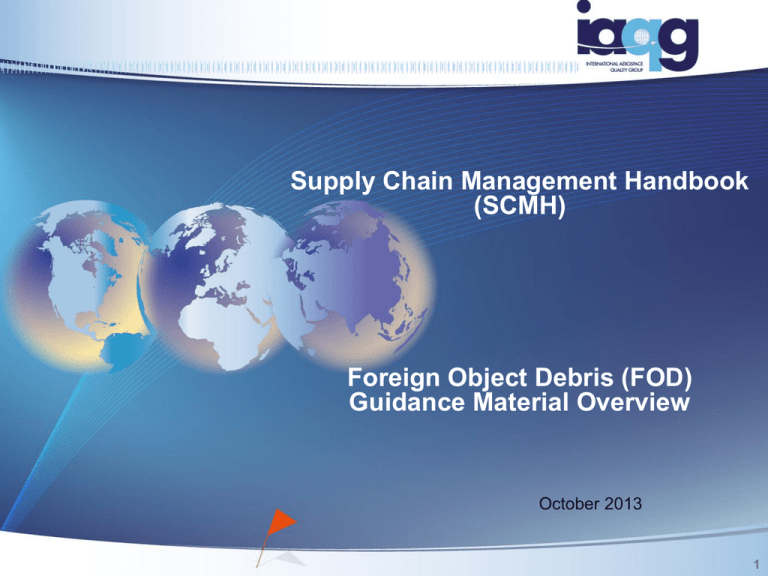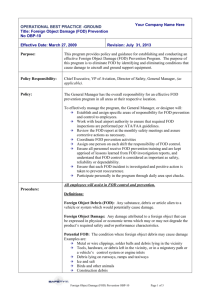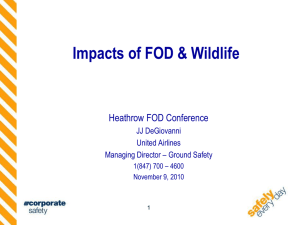Foreign Object Debris (FOD)
advertisement

Supply Chain Management Handbook (SCMH) Foreign Object Debris (FOD) Guidance Material Overview October 2013 1 Overview Content Supply Chain Management Handbook (SCMH) –A quick look. Foreign Object Debris FOD • Available SCMH Guidance Material • Page 2 • FOD Program Procedure • Prevention Tutorial • FOD Robustness Tool & Assessment Forms Discussion and Feedback Supply Chain Management Handbook (SCMH) A quick look at the SCMH www.iaqg.org/scmh Page 3 FOD Guidance Material Available Guidance Materials found in Chapter 7.3 I. FOD Program Procedure II. FOD Prevention Tutorial III. FOD Robustness Tool & Assessment Forms Referenced Documents • The processes and guidelines outlined in this section are based on; • NAS 412, the National Aviation, defense, and space Standard (NAS) • NAS 412 supports AS/EN/JISQ 9100, • FOD prevention policy/procedure of the Aerospace Industries Association (AIA). Page 4 FOD Program Procedure Background: • The impact of foreign object debris (FOD) remains a major concern in the aviation, defense, and space industry. • It is viewed as a major potential source of risk • Page 5 (condition + action) by regulators and customers. Lack of FOD prevention often leads to significant problems with the quality or cost of delivered product and ultimately threatens product and personal safety FOD Program Procedure The purpose of the SCMH Guidance Material is; • To outline fundamental approaches and provide basic guidelines for suppliers in the aviation, defense, and space industry to assess their processes and establish/implement a FOD prevention program • To provide effective means for suppliers to develop FOD prevention measures and policies through; • FOD baseline procedure • FOD checklists • FOD prevention training/tutorial • a risk-based FOD assessment process The aim is to prevent the occurrence and risk of FOD and improve the quality of industry suppliers by sharing best practices. Page 6 FOD Program Procedure What is FOD? • Foreign Object Debris (FOD) A substance, debris, or article alien to the component, assembly, system or vehicle that could cause damage. • Foreign Object Damage (FOD) Any damage or incident attributed to a foreign object that can be expressed in physical or economic terms that may or may not degrade the product’s required safety and/or performance characteristics. Page 7 FOD Program Procedure Part Family RiskBased Assessment FOD Assessment Re-Assessment Preventive Action Monitor Effectiveness Gap Definition Corrective Action Metrics Mitigation Process BASIC ATTRIBUTES OF A FOD PREVENTION PROGRAM Establishing and maintaining an effective FOD prevention program involves using a “continual improvement” cycle approach that proactively addresses the events (conditions and actions) leading to FOD. Page 8 Failures caused by FOD • Foreign material comes in many shapes and forms. It may present itself as a hand tool, dust, grime, oil, metal shavings, loose nuts, bolts, cotter pins, lock wire remnants, pencil, pen, packing material, etc. • It is a fact that foreign objects and/or debris have contributed to jammed flight controls, engine damage, electrical shorts, fluid contamination, control valve failures, fires and other major failure incidents that have resulted in costly material damage, loss of vehicle and of life. • FOD may cause many failures and damages, but worst of all – it might cause injuries and even loss of human life! • FOD can also cause damage to the company’s finances and reputation. Page 9 I. FOD Examples Page 10 I. FOD Examples Page 11 Examples Assembly Process Debris Fasteners-FOD This pump blew after ingesting several screws Small FOD can cause big problems. Page 12 The “degree” of FOD • Small particles are NOT FOD for some items, but are destructive and can cause failures in others. • So, FOD is a matter of the potential failure mode and the requirements of the product or item. • Even dust and dirt can be FOD if the item is small enough, but not a problem for larger equipment. • Engineering determination through a FMEA or other risk analysis is suggested Page 13 The “degree” of FOD Page 14 The “degree” of FOD Examples Small, seemingly insignificant items can lead to Big Problems Page 15 FOD Prevention Training Program The presented topics Include; • Objective • Definition • Training Program Topics: • proper storage; shipping & handling; techniques to control debris; housekeeping; cleaning, inspection; accountability/ control of tools, hardware, personal items, equipment and consumables; care and protection of end items; Quality workmanship (“Clean-As-You-Go,” Inspection); how to report FOD incidents or potential incidents • Examples of FOD • Outcome of FOD Page 16 FOD Prevention Training Program Presented topics include (continued); • Failures caused by FOD • What is 6-S • Proper storage, shipping and handling of material, components, and equipment. • Methods For Preventing FOD • Simple Rules To Help Prevent FOD • Lost Item Program • PEOPLE IN THE PROCESS • Responsibility for FOD • Resources Page 17 FOD Robustness Assessment Tool • PFRA Tool • Basic Assessment • Advanced Assessment • Robust Assessment • Test Cell Assessment • Assessment Summary Results • Basic Chart Page 18 • Advanced Chart • Robust Chart • Source Checklist • Containment • Mfg Process • Assembly Process • Control Audit FOD Requirements Tool Basic FOD Program Attribute Description Advanced Robust Req'd Act Req'd Act Req'd Act ≤4 0 ≤3 0 1 0 ≤4 0 ≤3 0 ≤2 0 ≤3 0 ≤2 0 1 0 ≤4 0 ≤3 0 ≤2 0 ≤3 0 ≤2 0 ≤3 0 1 0 1) FOD Awareness / Training: Training consists of Periodic Awareness Training that includes topics on Control of Personal Items, Equipment & Consumables; Care and Protection of Product; General 6-S & Clean as you Go principles; and Tool Control/Accountability. 2) Parts Protection / Material Handling Parts protection & material handling procedures exist. Materials and accessories used in Packaging, Handling, Shipping and Storage are free of any contamination. Parts and assemblies are packaged to preclude FOD contamination. 3) General Housekeeping, 6-S Practices Assembly, Test, Manufacturing, Warehouse, and Operational Support areas are clean according to 6-S principals. 4) FOD Reporting and Investigation All FOD events are reported and investigated and should include the use of common root-cause analysis tools as part of the record. Personnel are aware of how to react in the event of a FOD incident. E.g. Not to disturb evidence, to cease operation, notify supervision immediately and begin investigative process. Corrective actions need to ensure effectiveness to taken to prevent recurrence. 5) FOD Management / Leadership: High level procedures exist. FOD Focal Point established, has limited authority, >33% but < 66% responsibility commitment. 6) Assembly, Manufacturing, and Facilities Processes Assembly, Manufacturing, and Maintenance Tasks are planned and sequenced to preclude FOD and entrapment of debris or other contamination. Documents define necessary processes for preventing, cleaning, and ensuring FOD free manufacturing, assembly, and maintenance operations. Page 19 Example FOD Maturity Tool 3) General Housekeeping, 6-S Practices Assembly, Test, Manufacturing, Warehouse, and Operational Support areas are clean according to 6-S principals. Floors, w ork-surfaces and any other pertinent surfaces are cleaned / sw ept on an ad-hoc basis. No housekeeping aw areness for external contractors. Clean-as-you go is the goal but evidence of implementation is severely lacking. Floors, w ork-surfaces and any other pertinent surfaces are cleaned / sw ept on a periodic basis. External contractors are given FOD aw areness briefings as part of their standard-w ork. Clean-as-you go is the goal, but w ith little evidence of implementation apparent. A formalized 6-S program is in place in some areas of the facility. Floors, w ork-surfaces and any other pertinent surfaces are cleaned / sw ept on a periodic basis. External contractors are given FOD aw areness briefings as part of their standard-w ork. Clean-as-you go is the goal w ith some evidence of implementation apparent in some areas. A formalized 6-S program is in place in most areas of the facility. Floors, w ork-surfaces and any other pertinent surfaces are cleaned / sw ept on a periodic basis. External contractors are given FOD aw areness briefings as part of their standard-w ork. Clean-as-you go is the goal w ith strong evidence of implementation apparent in most areas. A formalized 6-S program is in place throughout the facility. Floors, w ork-surfaces and any other pertinent surfaces are cleaned / sw ept on a periodic basis and remain FOD free throughout the course of the day. External contractors are fully FOD briefed and maintain FOD Control w hile on the site, w ith FOD free status verified upon completion of w ork. Clean-as-you go is fully instilled through the entire facility. Page 20 5 4 3 2 1 FOD Containment Tool FOD Program Containment Checklist Source/Supplier: Part / Product Family: Assessed By: Vendor Code: Date: Y/N Objective Evidence / Comments Prevention Processes include measures to prevent contamination of high risk areas, i.e. those that can not easily be cleaned or are not conducive to reasonable and effective FOD detection. Process review validates that prevention measures are effective and suitable. Note: The ability to clean and detect needs to be taken into consideration. Cleaning Processes include measures to clean debris from all areas of product. Process review validates that the cleaning measures are effective and suitable. Note: The ability to prevent and detect need to be taken into consideration. Detection Processes include measures to detect debris in all areas of product. Process review validates that detection measures are effective and suitable. Note; The (FOD Coded) Quality Record of the source needs to be taken into consideration. Page 21 Feedback & Discussion Page 22



